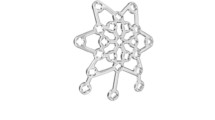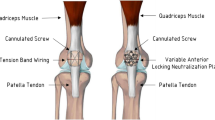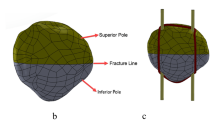Abstract
Introduction
Treatment of both simple and complex patella fractures is a challenging clinical problem. Although tension band wiring has been the standard of care, it can be associated with high complication rates. The aim of this study was to investigate the biomechanical performance of recently developed lateral rim variable angle locking plates versus tension band wiring used for fixation of simple and complex patella fractures.
Materials and methods
Sixteen pairs of human anatomical knees were used to simulate either two-part transverse simple AO/OTA 34-C1 or five-part complex AO/OTA 34-C3 patella fractures by means of osteotomies, with each fracture model created in eight pairs. The complex fracture pattern was characterized by a medial and a lateral proximal fragment, together with an inferomedial, an inferolateral, and an inferior (central distal) fragment mimicking comminution around the distal patellar pole. The specimens with simple fractures were pairwise assigned for fixation with either tension band wiring through two parallel cannulated screws or a lateral rim variable angle locking plate. The knees with complex fractures were pairwise treated with either tension band wiring through two parallel cannulated screws plus circumferential cerclage wiring or a lateral rim variable angle locking plate.
Each specimen was tested over 5000 cycles by pulling on the quadriceps tendon, simulating active knee extension and passive knee flexion within the range of 90° flexion to full extension. Interfragmentary movements were captured via motion tracking.
Results
For both fracture types, the articular displacements measured between the proximal and distal fragments at the central patella aspect between 1000 and 5000 cycles, together with the relative rotations of these fragments around the mediolateral axis were all significantly smaller following the lateral rim variable angle locked plating compared with tension band wiring, p ≤ 0.01.
Conclusions
From a biomechanical perspective, lateral rim variable angle locked plating of both simple and complex patella fractures provides superior construct stability versus tension band wiring under dynamic loading.







Similar content being viewed by others
References
(2020) Variable angle locking anterior patella plates 2.7 - Surgical Technique
Agarwala S, Agrawal P, Sobti A (2015) A novel technique of patella fracture fixation facilitating early mobilization and reducing re-operation rates. J Clin Orthop Trauma 6(3):207–211
Au B, Groundland J, Stoops TK, Santoni BG, Sagi HC (2017) Comparison of 3 methods for maintaining inter-fragmentary compression after fracture reduction and fixation. J Orthop Trauma 31(4):210–213
Carpenter JE, Kasman R, Matthews LS (1994) Fractures of the patella. Instr Course Lect 43:97–108
Carpenter JE, Kasman RA, Patel N, Lee ML, Goldstein SA (1997) Biomechanical evaluation of current patella fracture fixation techniques. J Orthop Trauma 11(5):351–356
Court-Brown CM, Biant L, Bugler KE, McQueen MM (2014) Changing epidemiology of adult fractures in Scotland. Scott Med J 59(1):30–34
Demirtaş Y, Katı YA (2023) A novel patella fracture fixation technique: finite element analysis. Arch Orthop Trauma Surg. 143(8):5105–5115
Finkemeier C, Nerlich M (2007) Patella AO principles of fracture management 2:801–813
Gao F, Yi M, Liu J, Zhang X, Xiang Z, Duan X (2023) 3D reduction combined with the modified Kirschner-wire tension band for the treatment of comminuted patella fracture. Arch Orthop Trauma Surg 143(4):1957–1963
Gardner MJ, Griffith MH, Lawrence BD, Lorich DG (2005) Complete exposure of the articular surface for fixation of patellar fractures. J Orthop Trauma 19(2):118–123
Gautier E, Sommer C (2003) Guidelines for the clinical application of the LCP. Injury 34:63–76
Gehr J, Friedl W (2001) [Problems in osteosynthesis of patella fractures with the AO tension belt and consequences for new implants. The XS nail]. Chirurg 72(11):1309–1317 (Zeitschrift fur alle Gebiete der operativen Medizen; discussion 1317–1308)
Hambright DS, Walley KC, Hall A, Appleton PT, Rodriguez EK (2017) Revisiting tension band fixation for difficult patellar fractures. J Orthop Trauma 31(2):e66–e72
John J, Wagner WW, Kuiper JH (2007) Tension-band wiring of transverse fractures of patella. the effect of site of wire twists and orientation of stainless steel wire loop: a biomechanical investigation. Int Orthop 31(5):703–707
Kfuri M, Escalante I, Schopper C et al (2021) Comminuted patellar fractures: the role of biplanar fixed angle plate constructs. J Orthop Translat 27:17–24
Larsen P, Court-Brown CM, Vedel JO, Vistrup S, Elsoe R (2016) Incidence and epidemiology of patellar fractures. Orthopedics 39(6):e1154–e1158
LeBrun CT, Langford JR, Sagi HC (2012) Functional outcomes after operatively treated patella fractures. J Orthop Trauma 26(7):422–426
Lorich DG, Fabricant PD, Sauro G et al (2017) Superior outcomes after operative fixation of patella fractures using a novel plating technique: a prospective cohort study. J Orthop Trauma 31(5):241–247
Lorich DG, Warner SJ, Schottel PC, Shaffer AD, Lazaro LE, Helfet DL (2015) Multiplanar fixation for patella fractures using a low-profile mesh plate. J Orthop Trauma 29(12):e504-510
Mueller ME (1961) Principles of osteosynthesis. Helv Chir Acta 28:198–206
Nerlich M, Weigel B (2000) Patella. AO principles of fracture management. Thieme, Stuttgart, pp 483–497
Nienhaus M, Zderic I, Wahl D, Gueorguiev B, Rommens PM (2018) A locked intraosseous nail for transverse patellar fractures: a biomechanical comparison with tension band wiring through cannulated screws. J Bone Joint Surg Am 100(12):e83
Patel VR, Parks BG, Wang Y, Ebert FR, Jinnah RH (2000) Fixation of patella fractures with braided polyester suture: a biomechanical study. Injury 31(1):1–6
Pauwels F (1966) Surprising success with the use of a traction binding in patellar fracture. Langenbecks Arch Chir 316:221–224
Schnabel B, Scharf M, Schwieger K et al (2009) Biomechanical comparison of a new staple technique with tension band wiring for transverse patella fractures. Clin Biomech (Bristol, Avon) 24(10):855–859
Schroeder S, Jaeger S, Schwer J et al (2022) Accuracy measurement of different marker based motion analysis systems for biomechanical applications: a round robin study. PLoS ONE 17(7):e0271349
Scilaris TA, Grantham JL, Prayson MJ, Marshall MP, Hamilton JJ, Williams JL (1998) Biomechanical comparison of fixation methods in transverse patella fractures. J Orthop Trauma 12(5):356–359
Siljander M, Koueiter DM, Gandhi S, Wiater BP, Wiater PJ (2018) Outcomes following low-profile mesh plate osteosynthesis of patella fractures. J Knee Surg 31(9):919–926
Siljander MP, Vara AD, Koueiter DM, Wiater BP, Wiater PJ (2017) Novel anterior plating technique for patella fracture fixation. Orthopedics 40(4):e739–e743
Smith ST, Cramer KE, Karges DE, Watson JT, Moed BR (1997) Early complications in the operative treatment of patella fractures. J Orthop Trauma 11(3):183–187
Stoffel K, Zderic I, Pastor T et al (2023) Anterior variable-angle locked plating versus tension band wiring of simple and complex patella fractures—a biomechanical investigation. BMC Musculoskelet Disord 24(1):279
Taylor BC, Mehta S, Castaneda J, French BG, Blanchard C (2014) Plating of patella fractures: techniques and outcomes. J Orthop Trauma 28(9):e231-235
Thelen S, Schneppendahl J, Jopen E et al (2012) Biomechanical cadaver testing of a fixed-angle plate in comparison to tension wiring and screw fixation in transverse patella fractures. Injury 43(8):1290–1295
Verbeek DO, Hickerson LE, Warner SJ, Helfet DL, Lorich DG (2016) Low profile mesh plating for patella fractures: video of a novel surgical technique. J Orthop Trauma 30(Suppl 2):S32-33
Wagner FC, Neumann MV, Wolf S et al (2020) Biomechanical comparison of a 3.5 mm anterior locking plate to cannulated screws with anterior tension band wiring in comminuted patellar fractures. Injury 51(6):1281–1287
Weber BG (1964) [Fundamentals and possibilities of traction osteosynthesis]. Der Chirurg. Zeitschrift fur alle Gebiete der operativen Medizen 35:81–86
Wendl K, Zinser R, Hochstein P, Grützner PA (2002) Frakturen der Kniescheibe Trauma und Berufskrankheit 4(1):30–37
Wild M, Fischer K, Hilsenbeck F, Hakimi M, Betsch M (2016) Treating patella fractures with a fixed-angle patella plate—A prospective observational study. Injury 47(8):1737–1743
Wild M, Windolf J, Flohe S (2010) Fractures of the patella. Unfallchirurg 113(5):401–411 (quiz 412)
Wurm S, Buhren V, Augat P (2018) Treating patella fractures with a locking patella plate—first clinical results. Injury 49(Suppl 1):S51–S55
Xue Z, Qin H, Ding H, Xu H, An Z (2016) Two-tension-band technique in revision surgery for fixation failure of patellar fractures. Med Sci Monit 22:2736–2741
Yang X, Wu Q, Lai CH, Wang X (2017) Management of displaced inferior patellar pole fractures with modified tension band technique combined with cable cerclage using cable grip system. Injury 48(10):2348–2353
Yoon YC, Sim JA, Hong JH (2017) Surgery of patellar fractures using a medial parapatellar approach. J Orthop Surg (Hong Kong) 25(2):2309499017719378
Zderic I, Stoffel K, Sommer C, Höntzsch D, Gueorguiev B (2017) Biomechanical evaluation of the tension band wiring principle. a comparison between two different techniques for transverse patella fracture fixation. Injury 48(8):1749–1757
Zhou M, Jia X, Cao Z et al (2023) Treatment of inferior pole patella fracture using Krackow suturing combined with the suture bridge technique. Arch Orthop Trauma Surg 143(6):2973–2980
Acknowledgements
This investigation was performed with the assistance of the AO Foundation via the AOTC System.
Funding
DePuy Synthes co-funded this study and provided all implants.
Author information
Authors and Affiliations
Contributions
SW, KS, WW, RC, JP, ESS, DLH and CS were involved in the conception of this study; SW, KS, IZ, and BG significantly contributed to the design of the work; SW, IZ, and BG were involved in data acquisition and analysis; All authors contributed to the interpretation of data; IZ drafted the manuscript; SW, WW, BG and CS substantively revised the manuscript. All authors have approved the submitted version.
Corresponding author
Ethics declarations
Conflicts of interest
The authors have no relevant financial or non-financial interests to disclose.
Ethical approval
All donors gave their informed consent inherent within the donation of the anatomical gift statement during their lifetime. Therefore, no local or national ethical approval was necessary. This study was performed in accordance with the Declaration of Helsinki.
Additional information
Publisher's Note
Springer Nature remains neutral with regard to jurisdictional claims in published maps and institutional affiliations.
Supplementary Information
Below is the link to the electronic supplementary material.
Rights and permissions
Springer Nature or its licensor (e.g. a society or other partner) holds exclusive rights to this article under a publishing agreement with the author(s) or other rightsholder(s); author self-archiving of the accepted manuscript version of this article is solely governed by the terms of such publishing agreement and applicable law.
About this article
Cite this article
Warner, S., Sommer, C., Zderic, I. et al. Lateral rim variable angle locked plating versus tension band wiring of simple and complex patella fractures: a biomechanical study. Arch Orthop Trauma Surg 144, 2131–2140 (2024). https://doi.org/10.1007/s00402-024-05266-w
Received:
Accepted:
Published:
Issue Date:
DOI: https://doi.org/10.1007/s00402-024-05266-w




